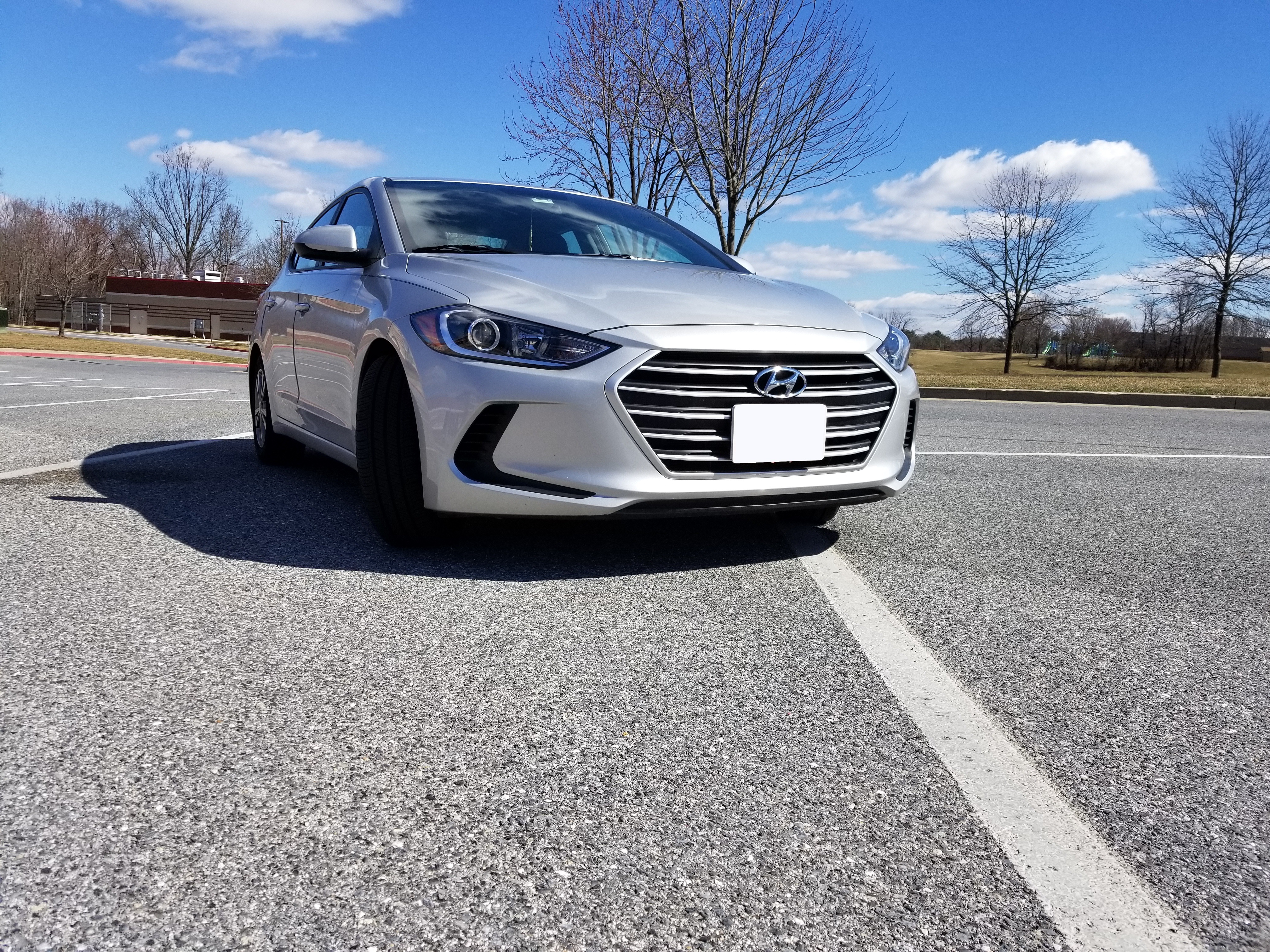
What is it?
The Elantra is hard to get a definite read on, and I found it quite difficult to find what this car's identity really was. The problem is that the Elantra, at face value, is an extremely neutral car. It features the short rear deck lid and low hood that the 2006 Civic popularized, a 2.0L Atkinson-cycle engine that makes respectable power, and gets decent gas mileage; it blends in to the modern economy car landscape flawlessly, but I think it was designed to. This is a car that exists to define itself not necessarily upon its own merits, but as a representative of the modern techniques and technologies that seem to unite all modern car designs. It ticks all the boxes for modern cars, and the result is...fine. It's a good car.
The Elantra shows that basic cars are no longer really basic. It has a touchscreen-based infotainment system that, while rudimentary, is quite serviceable, and functions as a backup camera display as well, with those becoming standard these days. Automatic headlights, blind spot warning, and multiple driving modes are also present, giving a pretty basic car a very surprising repertoire of features. The interior is comfortable, and while the styling is nothing to write home about, everything is placed where it should be, and the cabin stays pretty quiet. The car has cargo space appropriate for the compact economy sedan segment, with folding rear seats and a tall trunk, to give the rear end that cut-off pony car look that everybody loves these days.
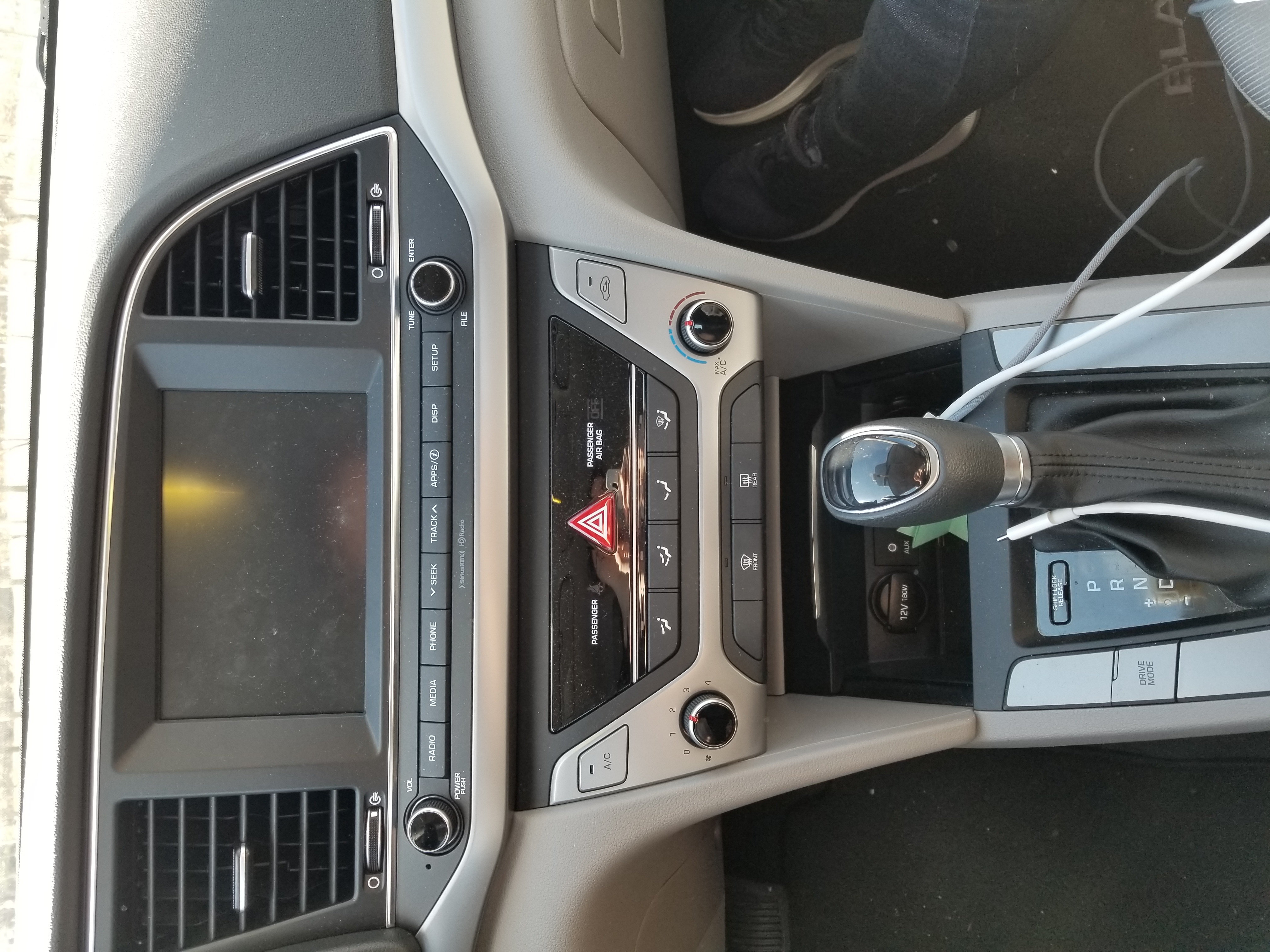
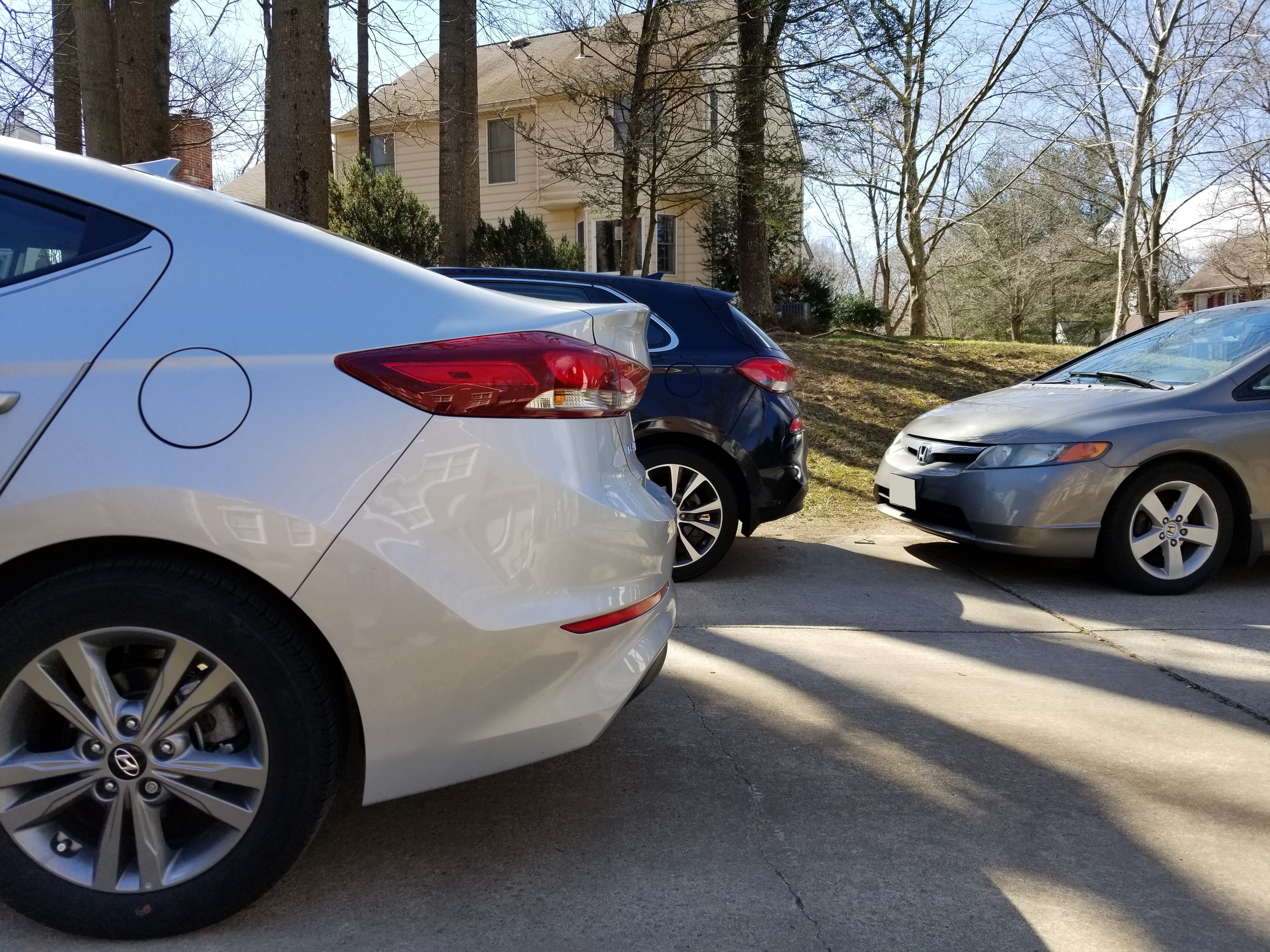
On the outside, the Elantra looks pretty normal, but as with all modern cars, any potential for "cute" styling is forgone in favor of a toned-down version of modern edgy styling cues, with sharp-edged light fixtures, a large, bold grill, hood features that complement the headlights like angry eyebrows, and the ever-present front bumper cheek "vents" that no modern car is complete without. The styling does a good job of keeping up with the times (every car needs to look like a sports car these days, apparently) while still being toned down enough for everyday use. Unlike the recent-generation Honda Civic, which features extraordinarily unique and forward-looking, if a bit aggressive, styling, the Elantra looks completely palatable without feeling too boring or outdated. The sweeping roofline presumably helps aerodynamics, though likely compromises rear seat room. If you want everyone to have head room, you should probably be looking at the Elantra GT hatchback instead. Again, as with all economy cars trying to survive the crash safety arms race brought on by the growing popularity of large, tall, heavy SUVs and crossovers, the window sills are rather high, which should be safer for a side impact collision, but makes the car look a little strange in profile. These don't affect interior visibility too much fortunately, with the C-pillars being visually unobtrusive for lane checks. The backup camera more than compensates for any loss in reverse visibility brought on by the tall trunk. Additionally, the low hood profile makes forward visiblity extremely good, and front end parking should be easy.

How does it drive?
In short, surprisingly well!
There seem to be two major schools of thought when designing economy cars: those that care about driving, and those that don't. These roughly parallel to the cynical view that people who don't much care for driving should get a car that only cares about driving a little more than they do, in favor of space, efficiency, and above all, price. This approach works fine for a lot of people because, let's face it, most people care more about comfort, features, and space than about cornering and acceleration. Most people like soft steering, no road feel whatsoever, and gentle throttle response, and that's fine! The other school of thought is one that feels that every car should be able to be defined on the basis of its own performance metrics. This means that such economy cars are fun and unique to drive while still being affordable and sensible. This is the school of thought that led to the huge following that Civics, both stock and modded, have accumulated. If you could afford a base model Civic coupe, an ECU reflash, and a fartcan, then you could afford a sporty car that felt personalized. Perhaps this is an artistic debate rather than an automotive one...
The Elantra's base model is Hyundai's 2.0L "Nu" family I4, developing about 147 horsepower and 132 lb-ft torque with an Atkinson combustion cycle. This motor doesn't rev extremely fast, but acceleration is surprisingly quick (for the car's size and price) and power output feels good across the performance envelope. Torque is lacking at low revs but that's to be expected, and the transmission kicks down appropriately to get the motor into its power band. Engine noise is unobtrusive most of the time, but is still audible, giving the driver good feedback about the engine load state and revs without having to check the gauge cluster. The engine compartment is a bit cramped, but the various fluid caps are at least easy to access, as well as the airbox and diagnostic port. There is particularly little room to work with the serpentine belt, so the user may find that annoying to work with, but that's not a huge priority for an economy car.
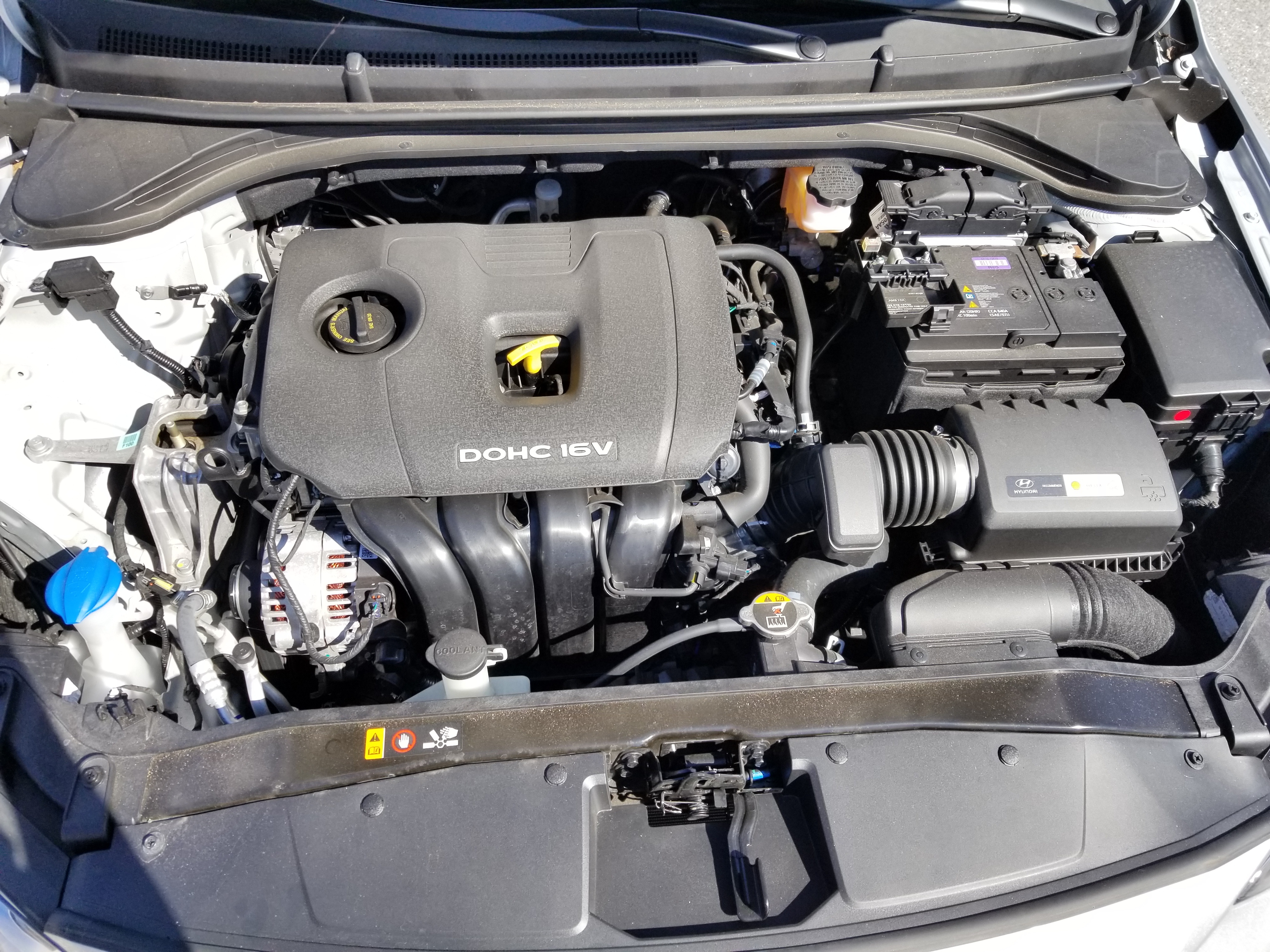
The three driving modes (eco, sport, and normal) affect power steering gain (like many modern cars, it's electric), throttle response, and transmission behavior, with Eco naturally being the most relaxed, with upshifts happening soon and often. There's no reason to not leave the car in Eco mode most of the time; you'll likely see an improvement of a couple mpg most of the time, and the soft steering and throttle behavior makes driving smooth. Sport mode makes the car much more lively without seeming like it's trying too hard to be mean and aggressive; throttle response is much quicker, though still not quite snappy, and the tighter steering makes the car feel more controlled. The transmission doesn't always behave logically in sport mode, and sometimes makes questionable or strange shift choices; manually shifting in Sport mode largely solves this. The normal driving mode is just that, being a reasonable medium between Eco and Sport; the transmission lets the engine rev a bit higher than Eco mode, making acceleration more responsive, and the throttle and steering are adjusted to feel normal overall. I would personally enjoy throttle response, transmission behavior, and steering gain to be individually adjustable (maybe have a "custom" drive mode where those parameters can be set by the user?), since I prefer tighter steering in all scenarios. That said, that kind of adjustability is really for enthusiasts, and this is not strictly a car for them.
Curiously, all three drive modes aren't accessed with the shifter (many cars have separate Drive and Sport detents), but rather with a button on the bezel surrounding the shifter boot. Because there is only one button (cycling eco->sport->normal), you might have to press it a couple times, and it can be different to find without good muscle memory, since it's flush with the surrounding styling. Power, Eco, and Normal should really be split into separate buttons so that any of them can be selected quickly and easily. Manual mode is quite fun, and while not usually necessary in Eco and Normal modes (unless you want to manually downshift for passing or something), as I mentioned before, it becomes more relevant in Sport mode, where the transmission feels confused. The shift input lag is faster than most automatic cars I've driven, and while not DCT-fast, it's quite pleasing, and keeps extended manual driving fun and engaging. The transmission protects the engine from lugging and overrevving, and will deny shifts that would rev it outside of safe ranges, as should be expected from a modern transmission. Overall, the Elantra's powertrain, and especially transmission, are fun and engaging while preserving comfort and efficiency, and really only lack on a couple aspects of the user experience. I had more fun playing around with the Elantra's powertrain than I did with the 2019 Dodge Charger!
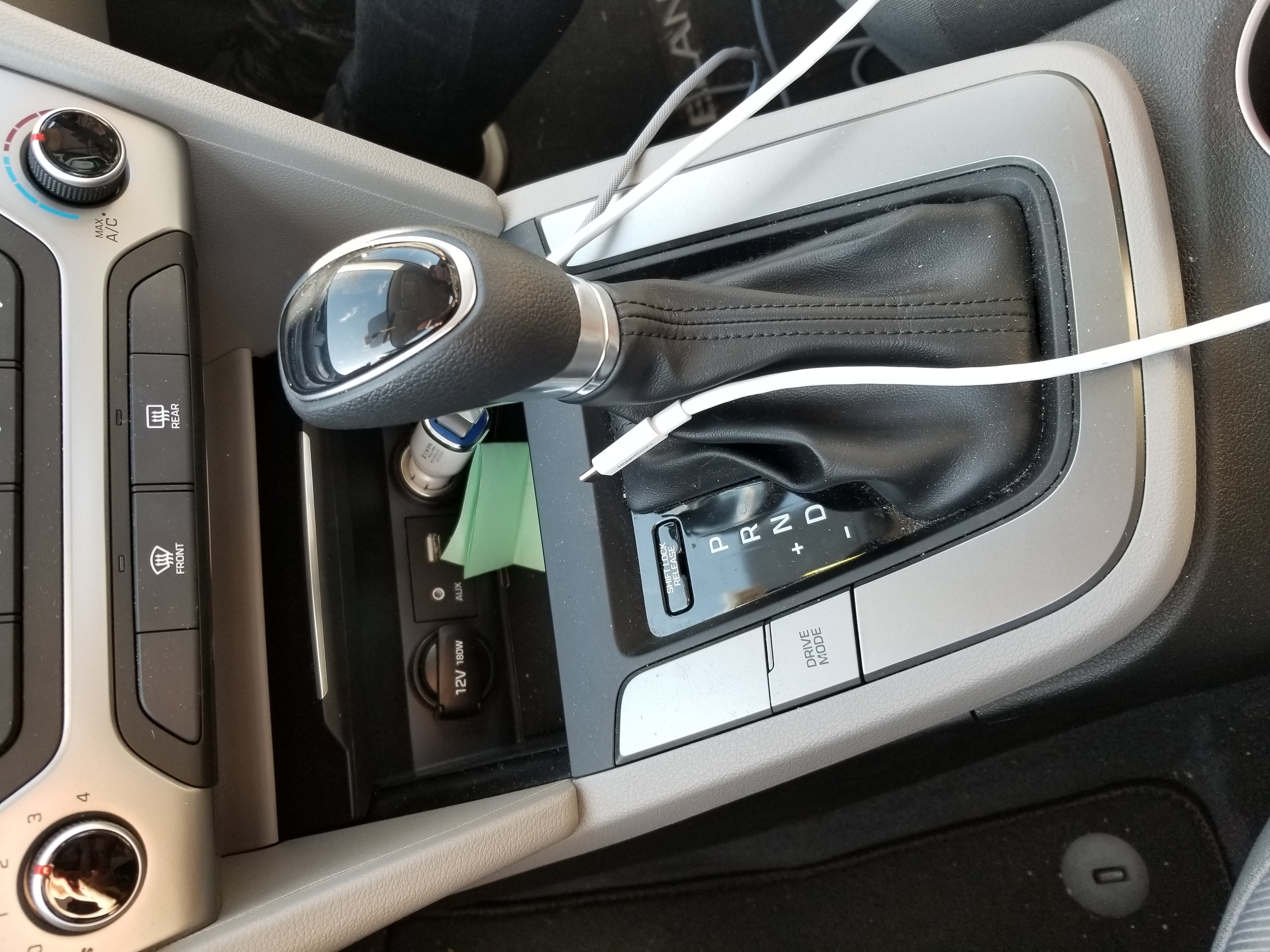
I was initially apprehensive about the Elantra's handling, since only the Sport version comes with multilink rear suspension, leaving all of the other trims to contend with a rear torsion beam. Fortunately, for most purposes the suspension feels fine! Many new cars have a well-damped ride that absorbs not only shocks but also useful road feedback. In the Elantra, I felt good feedback through the suspension, and in tight corners body roll was largely controlled. As with any car of this type, faster cornering will result in understeer, but the performance envelope is wide enough that for the most part that shouldn't matter. The car feels responsive and controlled in turns, avoiding being either too jittery or too loose. I am certain that the Sport's independent rear suspension handles both turns and bumps better but torsion beam is a reasonable compromise on a performance-for-cost basis, and shouldn't be discounted out of hand as a legitimate suspension option. There are a lot of ifs and buts about the Elantra's suspension design (if you fitted wider wheels/tires, if you added a secondary antiroll bar to the rears, etc etc) but overall it keeps the car composed in dynamic driving and is comfortable enough for normal driving. The turning circle is good for a car this size, and driving and parking in cities, with their tight turns and rough roads, should be easy, if not comfortable. The brakes are fine, by the way. All wheels have discs (it's 2019, don't accept anything with rear drums) and stopping power is appropriate for the car's size and weight.
The steering wheel is a little confusing (at least for someone who drives an older car like myself), but combines cruise control, gauge cluster display options, and media/phone controls at the user's thumbs. Unlike some cars, the Elantra didn't try to put so many buttons and dials on their steering wheel that they needed to offload controls to secondary paddles and stalks, like the Audi A4 Allroad or Subaru Outback. Traction control and blind spot assist can be manually disabled, and headlights are automatic, and overall all main controls are exactly where you expect them to be. Hyundai kept the simple things simple (you don't need a screen for HVAC control!) and put all the media controls where they make sense, and the driver has a good selection of displays for the multifunction gauge cluster display, including fuel economy, a digital speedometer, and music/media information. Hyundai did a very good of making the Elantra's user experience completely logical and easy to figure out, avoiding the trap of making the interior user experience needlessly complicated and unconventional to try and make the car's interior design stand out more.
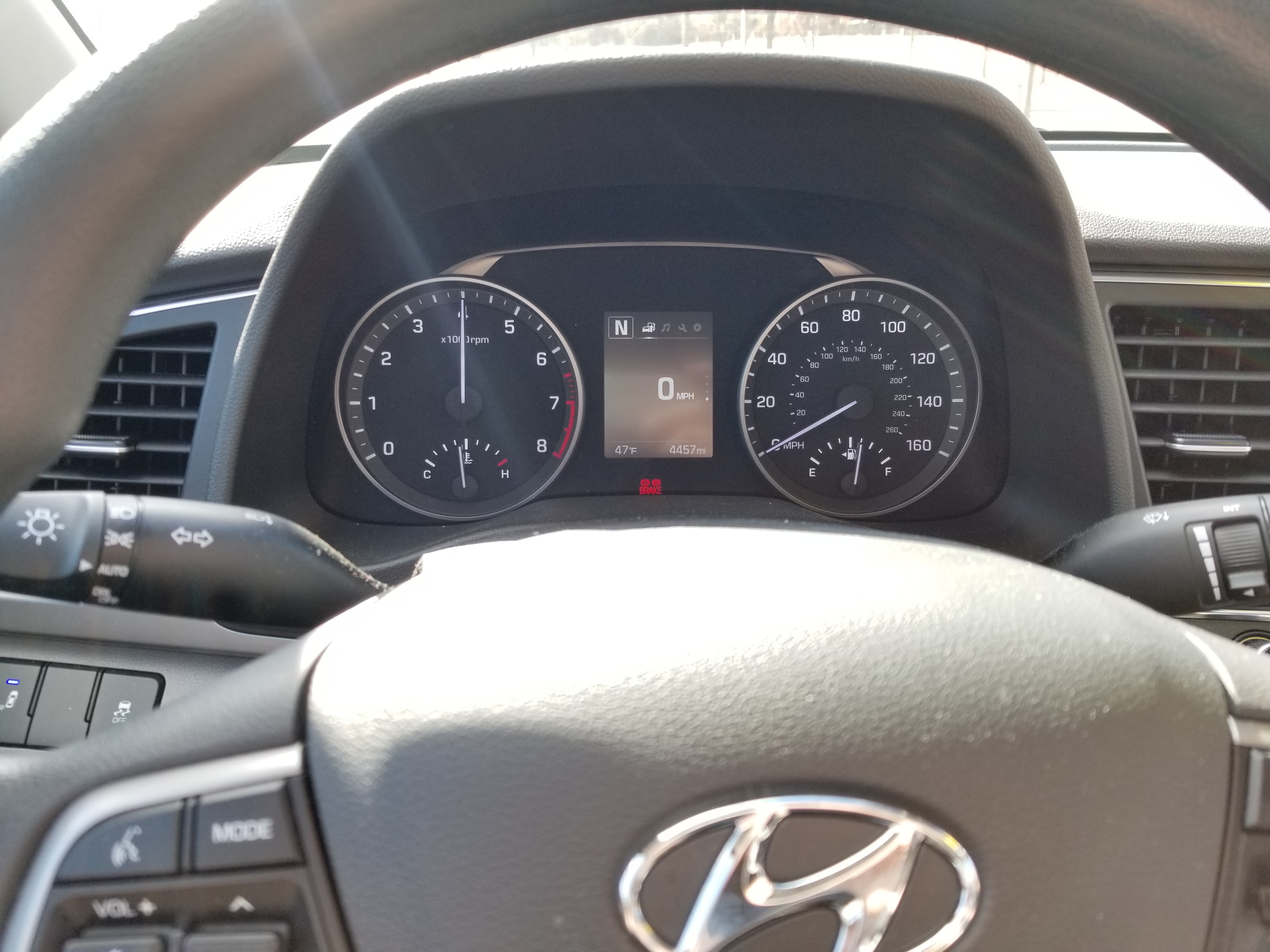
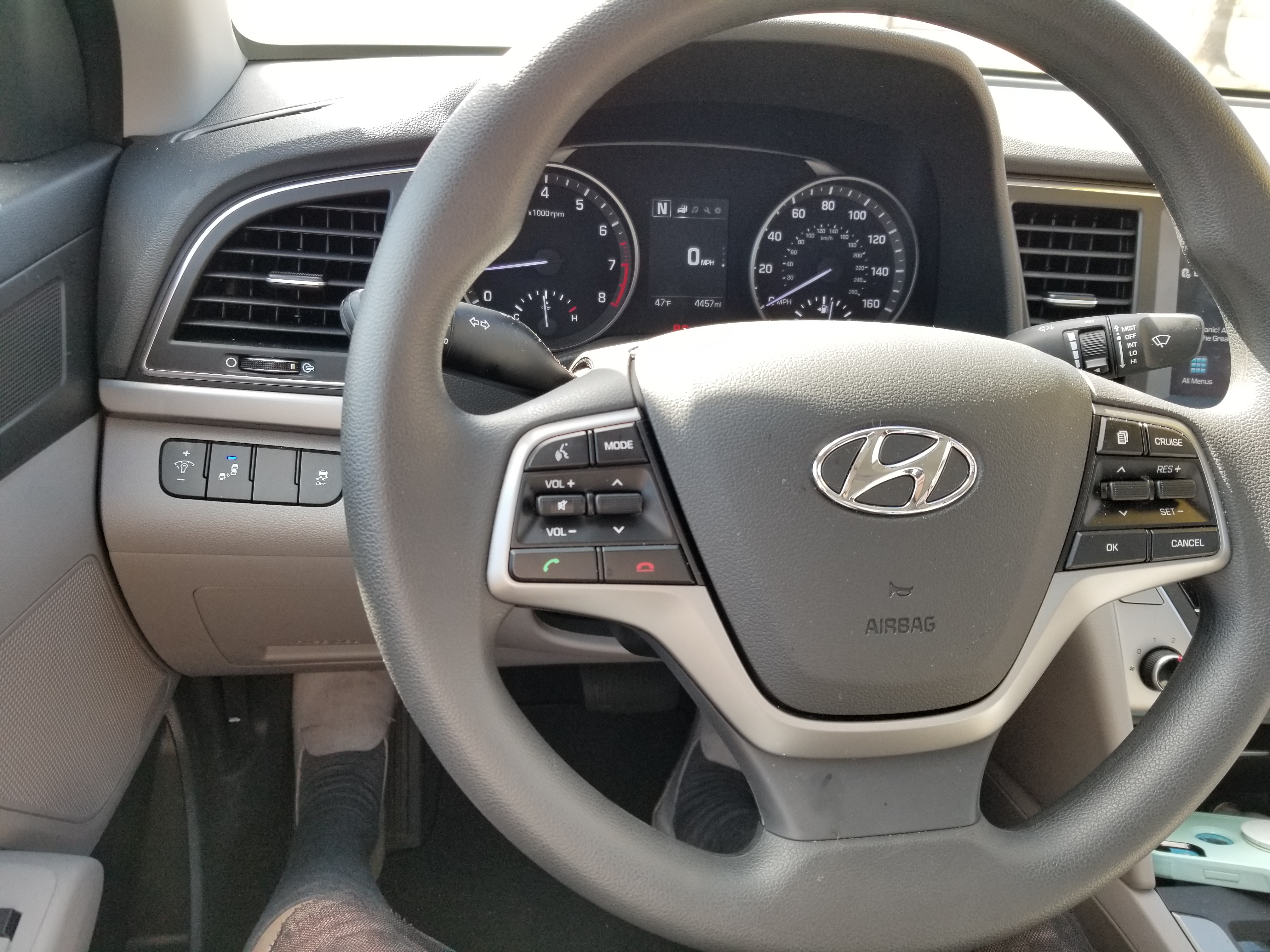
Most drivers should find the 2017 Elantra's driving experience to be capable, controlled, and free of nasty surprises. Even with the base model, power and acceleration are ample, the suspension is responsive and capable, if lacking the heavy damping and polish of many modern cars' road feel, and brakes perform well. For dynamic driving on twisty roads, or weaving up the interstate, the Elantra is well-suited. Obviously you shouldn't expect it to be some sort of sleeper track beast, but for most people, it's more than good enough. The Elantra, between its engine power, comfort, and fuel economy, should be good for both commuting and road trips, though with the latter you may start to notice its lower-end interior comfort and small size (which are effectively unavoidable for a car like this).
Who is it for?
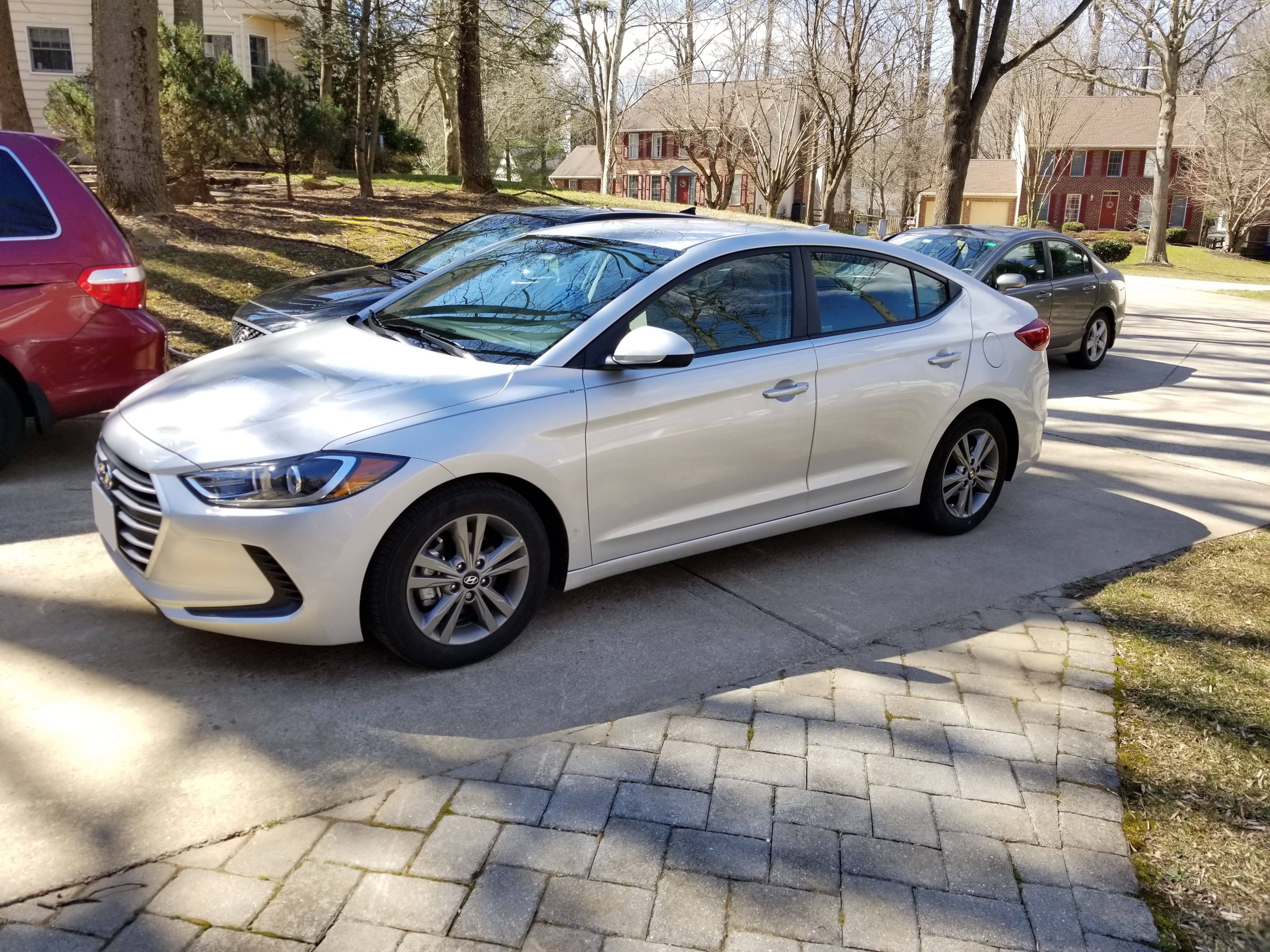
It's hard to get a read on what the Elantra wants to be, and who would be best served driving one. I think that the Hyundai Elantra, more than anything else, functions as a one-car demonstrator for the state of the modern auto industry. After all, what tells us the most about the state of the art is not the highest level of sophistication and power money can buy, but rather, the more forgettable, understated run-of-the-mill models, the ones that everyone is actually buying. In the case of the Elantra, it boasts contemporary driver assistance features like blind spot warning, automatic headlights, a reverse camera, and (optional) lane departure warning. The Elantra has a motor that offers a combination of fun and efficiency, and the transmission's multiple shift logic modes give the driver more options for how their car behaves. While not opulent, the Elantra is certainly well-equipped and doesn't feel like a base-level offering. What does this mean for the state of the art then? The Elantra tells us that driver assist systems are the new frontier for car technology development, while interior equipment is focusing more towards mobile device connectivity. Fuel economy is more important than ever, but so is driving pleasure, with floaty, boatlike suspensions being old hat. The Elantra perhaps doesn't exactly stand out for itself, more functioning as a competitively-priced, modern option for economy and econosport buyers, with Hyundai allowing the Elantra to exist in the context of its market segment rather than standing on its own as a particular cultural artifact (like the Civic arguably does.) If you're looking for a new car with fun performance, good fuel economy, and modern features, you could do a lot worse than the Hyundai Elantra. It won't turn heads, but it'll put a smile on your face for sure.